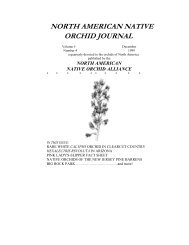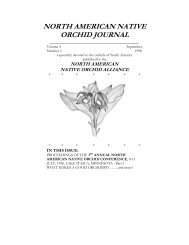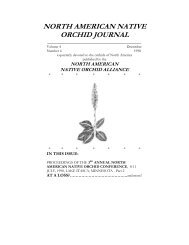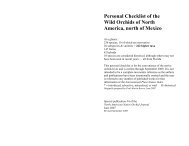north american native orchid journal - at The Culture Sheet
north american native orchid journal - at The Culture Sheet
north american native orchid journal - at The Culture Sheet
You also want an ePaper? Increase the reach of your titles
YUMPU automatically turns print PDFs into web optimized ePapers that Google loves.
Pelch<strong>at</strong>: SPIRANTHES PARKSII CORRELL – NAVASOTA LADIES’-TRESSES<br />
east of all other known popul<strong>at</strong>ions. Recent surveys of the Jasper<br />
County Black Branch Barrens area of the Angelina N<strong>at</strong>ional<br />
Forest have resulted in finding a few other plants (MacRoberts &<br />
MacRoberts 1997).<br />
Range/Habit<strong>at</strong><br />
Spiranthes parksii, with the exception noted above for Jasper<br />
County, inhabits the Post Oak Savannah region of East Texas.<br />
<strong>The</strong> Post Oak Savannah is a region loc<strong>at</strong>ed <strong>north</strong>west and west of<br />
Houston and occupies a space between the Blackland Prairies to<br />
the west and the Piney Woods to the east. To the south the Post<br />
Oak Savannah tapers out and mixes with the Blackland Prairies<br />
habit<strong>at</strong>, (Figure 1). This unique habit<strong>at</strong> is made up of an area of<br />
about 8,500,000 acres of gently rolling hills with elev<strong>at</strong>ions from<br />
65 to 300 meters above sea level. It receives about 75 to 115 cm<br />
of rainfall annually with the peak rainfall occurring during the<br />
months of May or June. Veget<strong>at</strong>ively it consists of open fields<br />
domin<strong>at</strong>ed by tall grasses and spots of woodlands th<strong>at</strong> are<br />
comprised mostly of post oak, Quercus stell<strong>at</strong>a and blackjack oak.<br />
Quercus marilandica. Soils consist of acid loamy sands in the upland<br />
areas to acid loamy sands and clays in the bottomland areas.<br />
(Correll & Johnston, 1970) <strong>The</strong> area was extensively cultiv<strong>at</strong>ed<br />
for grains, vegetables and fruit trees up through the 1940’s.<br />
(Wilson, unpublished) This cultiv<strong>at</strong>ion may explain the rarity of<br />
S. parksii and the disjunctive n<strong>at</strong>ure of some of the popul<strong>at</strong>ions.<br />
Within this range Spiranthes parksii is found mostly along<br />
drainage areas th<strong>at</strong> represent n<strong>at</strong>urally disturbed areas through the<br />
post oak woodlands leading to the Navasota River and is rarely if<br />
ever found in unn<strong>at</strong>urally disturbed areas such as roadsides,<br />
power-line right of ways or open fields (Wilson, unpublished).<br />
When I first began searching for this plant I looked in the open<br />
grassy areas near woods and along drainages areas [outside of<br />
woods] as described by others and as noted on herbarium sheets,<br />
e.g. Texas Intern<strong>at</strong>ional Speedway. Though I found some plants,<br />
mostly <strong>at</strong> the beginning of drainage areas from the grassy fields<br />
27













